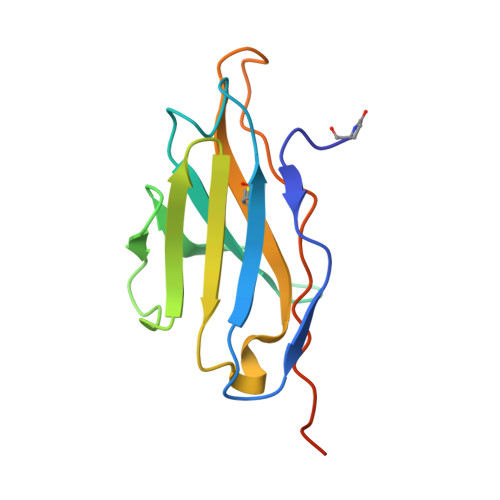A variable light domain fluorogen activating protein homodimerizes to activate dimethylindole red.
Senutovitch, N., Stanfield, R.L., Bhattacharyya, S., Rule, G.S., Wilson, I.A., Armitage, B.A., Waggoner, A.S., Berget, P.B.(2012) Biochemistry 51: 2471-2485
- PubMed: 22390683
- DOI: https://doi.org/10.1021/bi201422g
- Primary Citation of Related Structures:
3T0V, 3T0W, 3T0X - PubMed Abstract:
Novel fluorescent tools such as green fluorescent protein analogues and fluorogen activating proteins (FAPs) are useful in biological imaging for tracking protein dynamics in real time with a low fluorescence background. FAPs are single-chain variable fragments (scFvs) selected from a yeast surface display library that produce fluorescence upon binding a specific dye or fluorogen that is normally not fluorescent when present in solution. FAPs generally consist of human immunoglobulin variable heavy (V(H)) and variable light (V(L)) domains covalently attached via a glycine- and serine-rich linker. Previously, we determined that the yeast surface clone, V(H)-V(L) M8, could bind and activate the fluorogen dimethylindole red (DIR) but that the fluorogen activation properties were localized to the M8V(L) domain. We report here that both nuclear magnetic resonance and X-ray diffraction methods indicate the M8V(L) forms noncovalent, antiparallel homodimers that are the fluorogen activating species. The M8V(L) homodimers activate DIR by restriction of internal rotation of the bound dye. These structural results, together with directed evolution experiments with both V(H)-V(L) M8 and M8V(L), led us to rationally design tandem, covalent homodimers of M8V(L) domains joined by a flexible linker that have a high affinity for DIR and good quantum yields.
Organizational Affiliation:
The Department of Biological Sciences, Carnegie Mellon University, Pittsburgh, Pennsylvania 15213, United States.




















